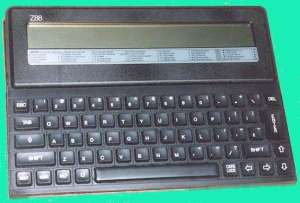
|
Manufacturer |
Cambridge Computer (UK) |
Model |
Z88 |
Date Launched |
Mid 1987 |
Price |
£230 |
Microprocessor type |
Zilog Z80A @ 3.2768 MHz |
ROM size |
128 kilobytes |
Standard RAM |
32 kilobytes |
Maximum RAM |
At least 416 kilobytes using three 128KB plug-in RAM cartridges at £50 each.
Theoretically up to 3 megabytes was possible but it is not clear whether suitable memory cards were ever produced.
Memory was paged to overcome the 64KB limit of the Z80A processor. |
Keyboard type |
Membrane keyboard with 64 raised keys.
The principle is similar to the keyboard of the ZX Spectrum but with a much improved feel. |
Supplied language |
BBC BASIC (as used with Acorn's computers) but rewritten to run on a Z80 processor. |
Text resolution |
104 columns x 8 lines.
Most software used 80 columns with the remaining width used for information panels etc. |
Graphics resolution |
640 x 64 pixels |
Colours available |
Liquid crystal display showed 2 shades of blue on grey |
Example Screenshot |

(Click for full size version)
For most applications the Z88's display was divided into 4 sections: on the left were general menu items, a large central section provided 80 columns for the main input/output, an application-specific section or a print preview to the right of this, then a column of status indicators (battery, CAPS etc.) on the extreme right.
|
Sound |
Single pitch beeps from internal speaker. |
Cassette load speed |
Not applicable.
The only storage for the Z88 was on memory cards, which could be either battery-backed CMOS RAM, or EPROM for more permanent storage.
One of the three card slots acted as an EPROM programmer but an external UV eraser was needed to clear the EPROM for reuse. |
Dimensions (mm)
Weight (grams) |
297 x 210 x 25
900 |
Special features |
A battery powered portable with integral screen, approximately A4 sized and weighing about 2 pounds.
Could transfer data to a desktop PC via a cable. |
Good points |
Supplied software (in ROM) included a combined word processor/spreadsheet/database (Pipedream), diary, alarm and calculator.
A low cost laptop computer.
The operating system allowed task switching.
Had a long battery life. |
Bad points |
Display was rather small to read.
As usual for Clive Sinclair it was launched before it was finished.
The BBC BASIC lacked an editor for correcting mistakes. |
How successful? |
Not as popular as it deserved to be.
Was well-liked by its owners but did not sell in the sort of numbers associated with earlier Sinclair computers. |
Comments |
Made a useful briefcase sized and cheap portable word processor.
The small display was not as restrictive as it might seem since it allowed eight lines and a full 80 columns for the editing area, plus separate status and menu sections.
Clive Sinclair had sold the design rights of the ZX Spectrum, and the Sinclair brand name, to Amstrad in 1986. The Z88 was his next (and final) entry into the computer market.
A portable computer along the lines of the Z88 had been considered by Sinclair Research several years earlier but never materialised.
The Z88 in general received good reviews but probably by 1988 the market wanted compatibility with DOS and IBM PCs, and more computing power than the Z80A microprocessor could provide.
Also, soon after the fiasco of the Sinclair C5 electric car, the Sinclair association was possibly a liability. |

